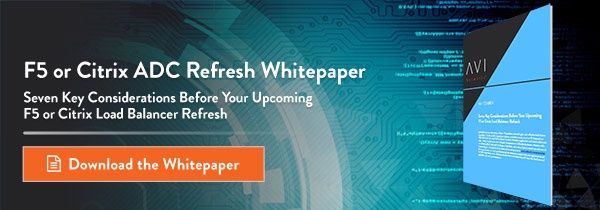Last week, my colleague Chris wrote about his "buyer's remorse" (not!). If you are an F5 BIP-IP LTM (or a Citrix NetScaler SDX or MPX) customer, I would like to get you thinking about software load balancers.
Enterprises have many issues with hardware and appliance-based load balancers. Some key struggles include:
- Stability: How fast and effective is the load balancer at redirecting server traffic loads, and how consistently can it perform? This is one area where hardware-based load balancers often excel—at least until they hit their limits for concurrent connections.
- Security: Does the load balancer provide resiliency against DDoS attacks or other system intrusion methods? Hardware load balancers frequently only supply minimal real-time protection against the most basic DDoS attack strategies.
- Scalability: How easy is it to increase your load balancer appliance capacity instantly? With a hardware appliance, scaling up instantly is nearly impossible. The only way to scale up is to install and integrate a new appliance (and this involves time and money). Or, IT must overprovision load balancer capacity.
- Cost Control: How much does the load balancer cost the company to use? Load balancing appliances require dedicated maintenance and replacement, separate from other data center infrastructure, increasing the total cost of ownership (TCO) for server assets.
Challenges with Hardware Load Balancing Appliances
Appliance-based load balancers have reached peak innovation and have entered the realm of obsolescence. Most hardware-only solutions share similar, and severe architectural limitations as application delivery controllers (ADCs) for the modern enterprise data centers.
Take, for example, the F5 BIG-IP LTM.
Concurrent Connections: F5 BIG-IP LTM limits the number of concurrent connections. Depending on the specific BIG-IP LTM version, the maximum number of concurrent connections handled can range between 5 and 100 million connections—while only 75K to 1.5M L4 connections can be processed per second.
Inelastic Scale: Scaling load balancing resources up or down in response to traffic demands is notoriously difficult when using a hardware-based balancer for application delivery. To make sure that peak demands are met, companies frequently have to overprovision for load balancing. This means paying for more load balancing capacity up front—which also means wasting money when the total traffic load is anything less than its peak.
Lack of Central Management: F5 BIG-IP LTM, and other hardware load balancers, lack central management for companies that operate out of multiple data centers. This restrics infrastructure and network admins from getting insight into the health of the app or network environment which enables rapid resolution of app or network incidents.
Hardware load balancers are expensive to deploy and maintain for larger organizations. (Don't take my word for it; calculate the savings you'd get from a software load balancer here)
Can a Software Load Balancer Do Better?
Short answer: YES!
Long answer:
- Software load balancers, by their very nature, eliminate the need for hardware installation. This makes itincredibly easy to scale load balancing resources up or down on the fly as needed.
- Software load balancers enable centralized management across a multi-cloud and hybrid cloud environments.
- Software load balancers such as the Avi Vantage Platform leverage their strategic position in the network to deliver APM-like insights into app/server health. This enhances the resiliency of software load balancers over that of traditional, hardware-based balancers such as the F5 BIG-IP LTM.
Moving from a Hardware to a Software Load Balancer
Moving from a physical load balancer to a software load balancer such as Avi Vantage can feel overwhleming. Therefore, Avi provides automated and manual support services/tools to make this trasition easier for enterprises.
- Automated Tools: Many configurations of a BIG-IP LTM configuration can be automatically imported into Avi Vantage’s JSON configuration format. This helps to smooth the process out, but not all functions can be carried over automatically.
- Manual Tools: About 75% of all iRules can be converted to native point-and-click features, but a professional services engineer from Avi will manually inspect the iRule to make such this determination. If a rule cannot be performed natively, it will be rewritten in Avi’s DataScript format—which is based on the modern Lua programming language for making plugins.
See for yourself why Avi Networks software load balancing solution is better than the F5 Load Balancer or Citrix NetScaler.
Drop us a note if you're interested in learning more about our F5 migration tools.




